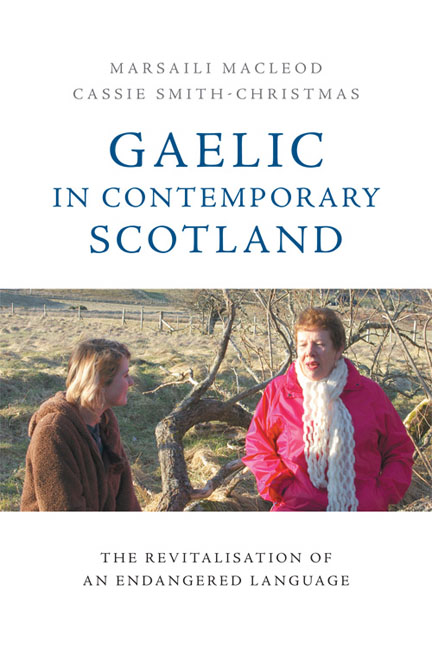Book contents
- Frontmatter
- Contents
- List of Figures
- List of Tables
- Notes on Contributors
- Foreword: Assailed yet Resolute
- Acknowledgements
- List of Abbreviations
- 1 Introduction
- 2 The Language of the Playground: Activists Building Consensus on the Language Policy and Ethos of a New Gaelic Immersion School
- 3 Mismatches between National and Local Gaelic Development: Cròileagan Dùn Èideann and the Promotion of Gaelic-medium Education
- 4 Gaelic amongst Schoolchildren: Ideas on Language Change and Linguistic Choices in Gaelic
- 5 When School is Over and Done With: Linguistic Practices and Sociodemographic Profiles of Gaelic-medium Educated Adults
- 6 New Speakers of Gaelic: A Historical and Policy Perspective
- 7 Learning Gaelic in Adulthood: Second Language Learning in Minority Language Contexts
- 8 Dlùth is Inneach: Charting Language Ideology in the Contemporary Gaelic World
- 9 Gaelic Language Use in Public Domains
- 10 Planning for Growth: The Professionalisation of the Taskforce for Gaelic Revitalisation
- 11 Organisational Language Planning: Gaelic Language Plans in the Public Sector
- 12 The Future of Gaelic Language Revitalisation in Scotland
- Index
10 - Planning for Growth: The Professionalisation of the Taskforce for Gaelic Revitalisation
Published online by Cambridge University Press: 18 December 2019
- Frontmatter
- Contents
- List of Figures
- List of Tables
- Notes on Contributors
- Foreword: Assailed yet Resolute
- Acknowledgements
- List of Abbreviations
- 1 Introduction
- 2 The Language of the Playground: Activists Building Consensus on the Language Policy and Ethos of a New Gaelic Immersion School
- 3 Mismatches between National and Local Gaelic Development: Cròileagan Dùn Èideann and the Promotion of Gaelic-medium Education
- 4 Gaelic amongst Schoolchildren: Ideas on Language Change and Linguistic Choices in Gaelic
- 5 When School is Over and Done With: Linguistic Practices and Sociodemographic Profiles of Gaelic-medium Educated Adults
- 6 New Speakers of Gaelic: A Historical and Policy Perspective
- 7 Learning Gaelic in Adulthood: Second Language Learning in Minority Language Contexts
- 8 Dlùth is Inneach: Charting Language Ideology in the Contemporary Gaelic World
- 9 Gaelic Language Use in Public Domains
- 10 Planning for Growth: The Professionalisation of the Taskforce for Gaelic Revitalisation
- 11 Organisational Language Planning: Gaelic Language Plans in the Public Sector
- 12 The Future of Gaelic Language Revitalisation in Scotland
- Index
Summary
Introduction
It is only relatively recently that scholars and the public have become aware of the accelerating loss of linguistic diversity around the world; consequently, the develop-ment of organised planning for survival in response to the crisis is also relatively new. Given that language planning for linguistic diversity is such a new endeavour, it is not surprising that a culture of professionalism and expertise among its practitioners is also still in the early stages of development. We have much to learn about what does and does not work when it comes to language planning in this respect, and there is also much work to be done in terms of disseminating this knowledge to those language planners, educators and activists working on the ground in indigenous communi-ties who might use it. This chapter explores the levels of training experienced and required by individuals involved in the implementation of planning interventions in the Scottish Gaelic context.
Background
In Scotland, the development of an organised, national response to the demographic decline of Gaelic-speaking communities is very recent indeed (see, for example, Dunbar 2010 and Macleod 2008). In the last quarter of the twentieth century, as language activists became increasingly concerned about the growing crisis in Gaelic-speaking communities, various initiatives in education, in the media, and in local-government service provision, were effected aiming to re-strengthen the transmission and use of Gaelic. These early efforts, while motivated by good intentions, were nonetheless characterised by a general lack of professional expertise. In the absence of a clear understanding of the nature of the problem, and without access to state-of-the-art theory of best practice in indigenous-language education and revitalisation, these early efforts tended to be of limited efficacy (McLeod 2002). Commenting in 2001, McLeod identified a lack of professionalisation in Scottish language planning bodies as a pervasive problem:
Despite the growing institutionalization of the Gaelic movement in Scotland – an institutionalization underpinned by millions of pounds of government investment every year – very little specialist professional expertise is brought to bear on Gaelic develop-ment, a phenomenon one activist has unkindly described as ‘amateur hour’. Almost none of those steering the various Gaelic organisations have any specialist training or experience in applied linguistics or language planning, and there is relatively little awareness of theoreti-cal and analytical advances in the field of language revitalization and language planning in general […]. (McLeod 2001: 23)
- Type
- Chapter
- Information
- Gaelic in Contemporary ScotlandThe Revitalisation of an Endangered Language, pp. 141 - 155Publisher: Edinburgh University PressPrint publication year: 2018



